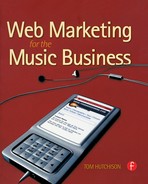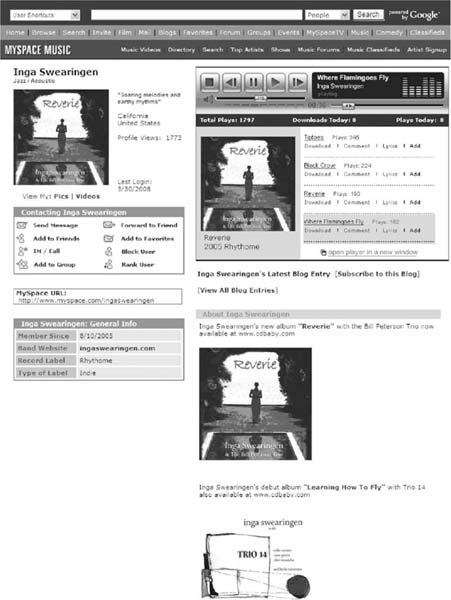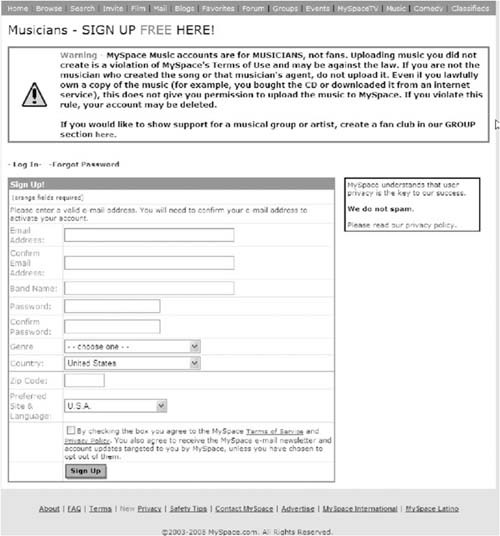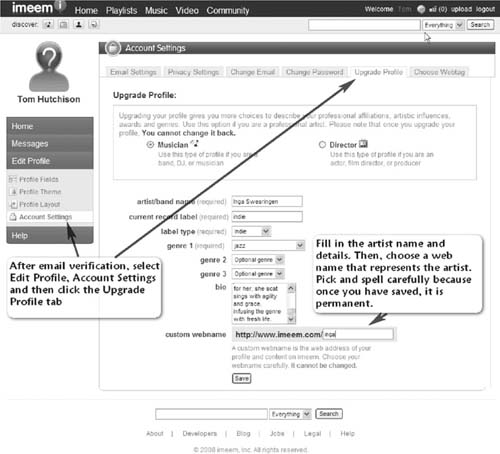CHAPTER 12
Social Networking Sites
Social networking sites are defined as “web sites that allow members to construct a public or semipublic profile and formally articulate their relationship to other users in a way that is visible to anyone who can access their file” (Boyd and Ellison, 2007). Social networking sites allow anyone to have a personal web presence. Characteristics that have made social networking sites so popular include the following:
1. They allow for self-expression.
2. They require little or no knowledge of web design.
3. They allow for social interaction and networking.
4. They are free or inexpensive to use.
RISE AND POPULARITY OF SOCIAL NETWORKING SITES
The first significant social networking site was classmates.com, founded in 1995. Classmates.com allows for high school and college classmates and graduates to stay in touch. The site is still going strong today but has been joined by, among others, Friendster.com, founded in 2002, MySpace, founded in 2003, and Facebook, founded in 2004. According to Hitwise, a company that specializes in online web traffic and marketing, visits to social networking sites accounted for 6.5% of all Internet visits in February 2007. At that point in time, MySpace accounted for 80% of the market share, with Facebook holding 10% of the market. Other services such as Bebo, BlackPlanet, Classmates, Friendster, Orkut, and imeem accounted for less than 1% each. The same press release stated that “Buzznet and iMeem are succeeding in building communities around music” (www.hitwise.com/press-center/hitwiseHS2004/socialnetworkingmarch07.php). By April 2007, Facebook had grown its market share to 11.5%, doubling its traffic since opening up its service to Internet users without school affiliation. The year 2007 was a watershed for musicoriented social networks as a host of upstarts were all vying to be the next MySpace. By the end of 2007, the other social networking services had begun to encroach on MySpace's commanding lead, which had declined slightly to 76% for the year and 72% for December 2007. Facebook had continued its growth to 16% by December, with Bebo and BlackPlanet moving over the 1% mark. In early 2008, imeem acquired fledgling online retailer SNOCAP.
The article “Could Social Networking Save the Music Industry,” on www.ciotoday.com (January 2007), professed that the new generation of social networking sites that emphasize music might be just what the industry needs to pull teens and young adults away from illegal file-sharing networks and back into the world of legal music consumers. These advertiser-supported sites offer what cio-today calls “a better form of free” for consumers.
MYSPACE
Because MySpace has the lion's share of social networking traffic at the time of this writing, it should be looked on as the most important social networking site worthy of marketing efforts. However, this could change as other sites vie to compete in the marketplace, hoping to offer new and exciting services to lure web visitors away from MySpace and Facebook.
Signing Up and Setting Up Your Band Site
For artists, MySpace's setup is ideal for promoting music. Some of the features for artists include a built-in music player, user ratings, reviews, artist rankings, featured bands, show listings by location, and music videos. MySpace launched its own record label in 2005 with arrangements made for distribution through Universal Music Group. Through the online retailer SNOCAP, MySpace now offers all its independent artists the chance to sell downloads from their MySpace page.
To get started, you will want to use your e-mail address to sign up for an artist account and not a personal account. If you already have a personal account, you will need to use a different e-mail address to sign up for the artist account. If you wish to keep your current e-mail address the same, you can delete your personal account on MySpace or change the e-mail address on your personal account. To sign up for an artist site on MySpace, locate and click on the “music” link on the menu bar (not the search menu in the top banner). When the MySpace music page opens, click on “artist signup.” You will get a chance to specify up to three genres under which your artist will be categorized, but on the signup page, you pick the primary genre and enter the band's name. This will become the artist's address at www.myspace.com/artistname. To complete the registration, you get the chance to list the artist's web site address, the three genres under which you want the artist categorized, and the artist's label affiliation.
You have the option of including crucial artist details in the artist profile, such as a bio, list of band members, upcoming shows, musical influences and comparisons, and the URL of the band's official web site. At this point, you get the chance to invite friends to sign up and to upload photos and audio files, but you must use the MP3 format for audio files. Use the “manage songs” page to upload up to six songs. You can specify whether listeners are allowed to download the song or merely stream it to their computers. You can also assign an image to each of the songs in your profile. For future editing of songs, band details, tour dates, and so on, click on the “edit profile” link. When adding a song to the site, you have the option to allow users to add your song to their profile, to auto-play the first song when people visit your page, or to randomize song play. Depending on the parameters you set, your visitors can have the option to listen to the songs in your music player, rate your songs, comment on them, download a copy, view the lyrics, or click a link to add the song to their own MySpace page.
To change the default photo on your site, click on the “add/edit photos” link. Select the photo from the correct album by double clicking the photo, and then click on “set as default.” Through the “manage address book link” you have the opportunity to build an address book of MySpace users and manage outgoing and incoming mail. To collect e-mail addresses of visitors, you can embed a mailing list signup form into the profile page. MySpace offers much more than internal networking. The simple web address assigned to each artist makes it possible to use the MySpace page as the main Internet presence for an artist, allowing for music sampling, posting of the tour schedule, blogging, and much more. Or for artists who have a web site but need help setting up a listening page or an online retail presence, they can now simply link to their MySpace page for this service. It is advised that if the MySpace page is used primarily for music sales, keep the clutter on that page to a minimum so visitors can focus on the music.
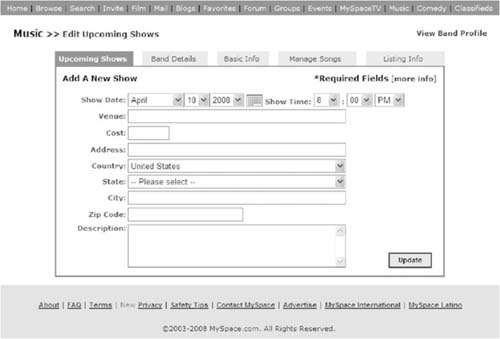
FIGURE 12.3 Edit upcoming shows or add a show date on MySpace. (Printed with permission from MySpace.)
Formatting the artist's page can be a challenge. MySpace offers flexibility with page formatting, but within parameters. The default profile for artists features the artist name and photograph on the left side of the page, with a music player on the right side. Underneath the photo on the left side are the communications buttons and general information. Beneath the music player on the right side is the SNOCAP store. Customizing the page, also known as “pimping,” can involve simple changes in scheme color, and font style, or it can involve drastic template makeovers, many of which are available either free or for a small fee on the Internet. Make sure that your new layout follows the design rules presented in Chapter 5. Too many MySpace sites have been loaded down with background graphics that mask portions of the text and render it unreadable. Installation is usually simple: Pimp-My-Profile.com states, “To install a layout, copy & paste the layout code into the ‘about me’ section of your profile” (www.pimp-my-profile.com).
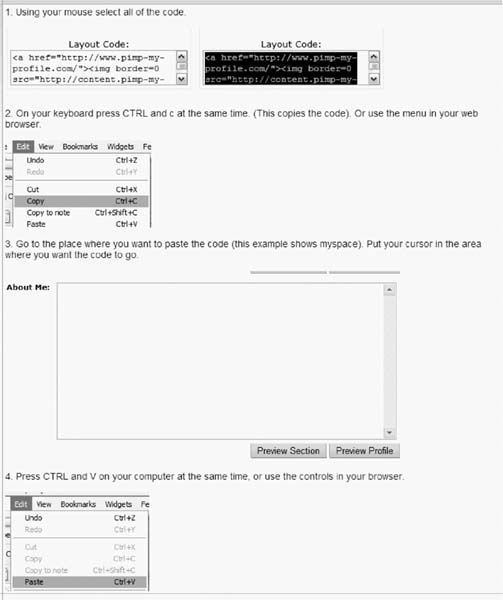
FIGURE 12.4 Installing code from a third-party developer to a MySpace page. (Printed with permission from MySpace.)
Subtle customization can be achieved with a few basic HTML commands (see Chapter 6). Use the “Edit profile” feature to access fields such as the “bio” section under band details. Basic HTML language can be inserted in the text to change fonts and text styles and to include links. Then click preview to see the changes. Not all fields read and respond to all HTML commands, so some experimentation is necessary to see what works and looks good. You can also use an outside HTML editor, where you can set the text in a WYSIWYG program and then copy and paste the resulting code. Images can be added to many sections of a MySpace page. Keep photos at the proper size, no greater than 450 × 550 pixels. Also, thumbnails of the profile photo will appear on friends' MySpace pages, so don't use an image with lots of small detail. Keep the composition of the profile photo to an image that would resemble what is found on a postage stamp.
Because MySpace opened up its platform to third-party developers, many widgets are available to spice up a web site. Again, integrating these into the MySpace page is as simple as copying a prewritten code into the proper place or clicking on an icon on the third party's site (see widgets, Chapter 6).
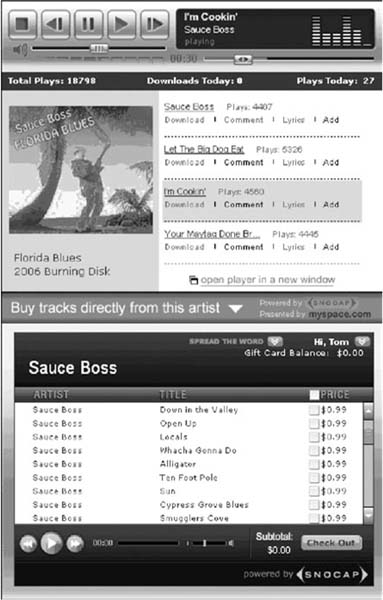
FIGURE 12.5 SNOCAP on a MySpace music page. (Printed with permission from MySpace.)
To sell music on MySpace through SNOCAP, you must first set up a SNOCAP account (at the time of this writing, the $30 fee was waived for the first year) and upload your music. Once that is completed, a MySpace Music Store will be automatically created on your artist's MySpace page directly under the MySpace music player. The agreement with SNOCAP is nonexclusive, meaning that you are still free to sell the same music through other outlets. Your fans will be allowed to purchase music directly from your profile page at a price you specify. The system allows you to offer up to 100 tracks with 30-second samples of each. More information on SNOCAP can be found at www.snocap.com/about/faq.
Networking and Promotional Techniques
Networking on MySpace is accomplished by requesting to add a “friend.” A friend is someone you exchange profiles with, so that your profile and link appear on your friend's page and your friend's profile and link appear on your page (Nevue, 2005). “Theoretically speaking, the more ‘friends’ you have, the larger ‘network’ you have to promote your music to (Nevue, p. 109). You can build your network by going to friends' pages or pages of artists similar to your own and see who is in that person's Friend Space. Then you can click on the photo to be directed to that person's profile and page. If any of these new contacts seem like good potential fans, you can request to add them to your artist's Friend Space (Brothers and Layton, 2007). If they are unfamiliar with your artist, they may visit your artist's page and check it out before deciding whether to approve the friend's request. (More information can be found in Chapter 11.)

FIGURE 12.6 Example music forums. (Printed with permission from MySpace.)
It is also possible to find members of the target market by using the music forums or the directory to find similar artists. Then by visiting their sites, you can again look through their Friend Space.
In the book MySpace Music Marketing, author Bob Baker suggested the following to locate your potential fans:
- Use the search feature to input specific keywords related to your artist, their sound, or other things of interest to their potential fans.
- Look through the Friends list of similar artists to find potential fans. By clicking on “view all of artist X's friends,” you can scroll through and click on the photos to get their individual profiles.
- Look through the comments section of similar artists for particular comments that may indicate whether or not this person is a potential fan.
- Use the browse feature to search for potential fans based on demographic characteristics.
Once you have developed a list of friends, cultivate these new fans by engaging in many of the opportunities MySpace has to offer. One is that any MySpace user can add a streaming song to his or her personal profile page. For your artist's music that has been uploaded to the MySpace music page, be sure to allow users to add your song to their personal page for streaming. Then, whenever anyone visits that person's page, the song will automatically play. This feature can be activated through the manage songs section of the music page. Then, as you find potential fans, ask them to add your song to their own profile page. Baker even suggested making it into a contest, with everyone who participates being entered into the contest.
My Bulletin Space is a feature that allows members to post bulletins that appear on all their friends' pages for 10 days. Bulletins can only be posted on another person's page by people who are part of that person's network of friends, and they do not show up on the public profile page for that person. Artists will often use the feature to broadcast information about upcoming live shows. For MySpace members who are a part of an artist's group of friends, they will see these bulletins about upcoming shows when they log on to their MySpace page (MacPhearson, 2007).
Making regular entries to the blog is another way for artists to engage fans and keep them coming back to the MySpace page. Stories from the road are often interesting fodder for blogs, along with stories behind the songs and milestones in the artist's career. Make blogs personal by writing in the first-person tense. Ask fans to subscribe to the artist's blog, which they can do by clicking the link right after “latest blog entry” on the artist's page.

FIGURE 12.7 Example of My Bulletin Space with artist postings. (Printed with permission from MySpace.)
MySpace also features classified ads. This section gives musicians a chance to post classifieds, whether it's offering entertainment services, looking for a new drummer, or buying or selling musical equipment. Classifieds are sorted according to geographic location and subject area. Look for the “classifieds” button on the top menu bar, usually the button on the far right. If geography is important, the next step is to click the “change city” button to the relevant city. Most major U.S. cities are listed. If the city of importance is not on the list, select the nearest major metropolitan area from the list. One of the subject options is Musician's XChange, which features musical equipment for sale and job opportunities.
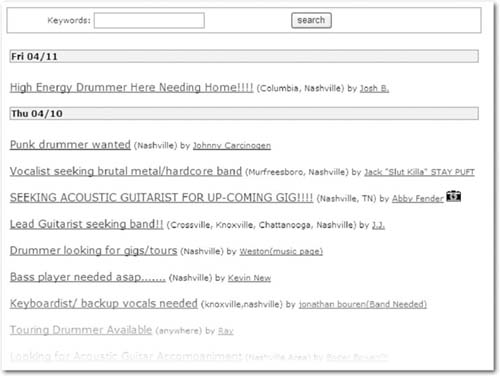
FIGURE 12.8 Classified ad postings on MySpace. (Printed with permission from MySpace.)
The classified section also allows users to search by keyword. Similar to Craigslist, the classifieds are listed by the date of posting, with the newest postings first. Artists and record labels are known to use MySpace to recruit members of the target market to work as street teams, either online or in the traditional sense.
EXAMPLE OF A SOCIAL NETWORKING STREET TEAM SOLICITATION
Groups » LEON HIGH SCHOOL!! » Topics » Teen Street Team Members Needed Posted: Aug. 11, 2007 9:48 PM
Do you love attending exciting events? Do you like to be the center of attention whenever you enter a room? Are you interested in working in the music or fashion industry? If you answered yes, then you have what it takes to become a Blu Diamond! As a Blu Diamond you will be the life of the party at every Blu Diamond Event and best of all you're getting paid to be!
The Blu Diamonds are young ladies, ages 14–18, whose primary responsibilities include:
Promoting Blu Diamond Events—Hip Hop and R&B parties for teens ages 14–18 held every other month at local hotspots.
Assisting with the planning of upcoming events—Show your creativity by planning the hottest teen parties in town.
Attending monthly meetings to stay up-to-date—Our monthly meetings are fun as well as informative. Refreshments and raffle prizes are always provided by Blu Sapphire Promos.
Attendance at fundraisers such as car washes and sponsorship nights at local restaurants.—Our car washes and dinner fundraisers help us to raise money for things such as new t-shirts and other clothing items, the hottest DJs in Tallahassee, and to throw the hottest theme parties in town.
Attending Blu Diamond Events at local hotspots acting as either waitresses, photo crew, admissions, or hype girls.
We are currently in search of new girls between the ages of 14–18 to join the team. Please send a message AND add us as a friend if you are interested in becoming a Blu Diamond.
Street Team Members are paid based on the number of guests they bring to each Blu Diamond event. All promotional materials such as t-shirts, a web site, and flyers are provided to ensure your success. If you are interested in becoming a part of Tallahassee's underground music industry please send us a message with the following information:
Name
Cell Phone Number
Age
School
Grade
Favorite R&B Artist
Favorite Hangout Spot
Other Clubs/Sports you're a part of Make sure to add us as a friend so that we can view your MySpace page. If your page is private and we can view it we will not be able to respond to your message.
Permission granted from www.myspace.com/blu_sapphire.
MySpace also has a section called groups. These are “user groups” based on topic of interest and allow for members to find and interact with other members who share their interest in the group topic. User groups first appeared on the Internet early on in its development, with the first user groups dedicated to science and technology. Some of these groups were oriented around areas of research study at universities, and the groups allowed for like-minded people to exchange knowledge and ideas in the subject area of study. As the Internet grew, so did the variety of offerings for user groups. Soon, user groups were springing up on services like CompuServe and dedicated to almost any topic or area of interest, including computers, music, and science.
On MySpace, there are more than 300,000 music groups and more than 60,000 “Nightlife and Clubs” groups. Some of the groups are fan clubs for specific wellknown artists, whereas others may be genre oriented. Peruse through the list of groups and read the descriptions of groups that may be relevant to promoting your artist. For example, the “Bay Area Music” group features musicians and bands from the San Francisco area.
MySpace announced in April 2008 that MySpace Music would be expanded to enable artists to sell music downloads, concert tickets, and merchandise through their profile pages and ringtones through MySpace's sister company Jamba mobile service. The major labels are slated to get onboard and resolve previous copyright disputes with the social networking service (Veiga, 2008).

FIGURE 12.9 MySpace example of a user group. (Printed with permission from MySpace.)
The Facebook social networking site has about 10% of the networking traffic as of late 2007. Originally available only to students with a school affiliation, Facebook opened its ranks to the public in September 2006 and doubled its traffic in one year (Hitwise). In May 2007, the site opened its platform, allowing software developers the chance to create integrated programs. From this, we are beginning to see more music-related applications. One such application dedicated to music is iLike. Born from garageband.com, iLike catalogs what users listen to through iTunes and other computer music players, compiles lists of recommendations, and allows users to share their music with friends.
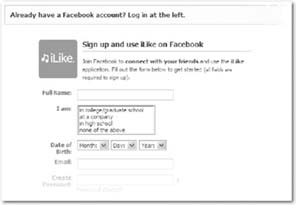
FIGURE 12.10 The iLike artist “add songs and events” page. (Courtesy of iLike.)
According to iLike, it promotes music democracy by exposing artists that users have not heard of but may like, according to their listening habits.Users download an iTunes sidebar that tracks their listening habits, which can be easily posted on their Facebook profile page.
For artists attempting to promote their music on Facebook through iLike, the iLike FAQ page offers the following tips:
1. Sign up on iLike and customize your artist page by adding your songs, concert schedule, and links. This will create an artist or band page for you on iLike. (The service is now set up to add iLike to your MySpace page.)
2. Ask your fans to sign up for iLike (at iLike.com or on Facebook.com) and “iLike” you. Then, ask them to add your music to their profile page. Then when their friends visit their page, it will expose them to your music. You can create a link guiding your visitors to the sign-up page. Go to your artist page on iLike.com and copy the links from the “Link to this page” section on the right-hand side of the page.
3. Have your fans install the iLike Sidebar, enabling them to document their listening patterns. If they listen to your music, and if enough of them do this using the iLike sidebar, your music will automatically work its way into the iLike music recommendation system and charts.
On Facebook, a person's iLike section shows up on their profile page with information on songs and artists they like and other music-related preferences. Artists on a person's profile list have the opportunity to post new events (mostly upcoming concert appearances) on the artist activity page.
YOUTUBE
YouTube is a video-sharing web site that opened in 2005; it has become very popular and created quite an impact in popular culture. Candid and bootleg videos have rocked political campaigns, spawned a new generation of videographers, launched new celebrities, and exposed others (i.e., the Michael Richards incident1). Artists have been exploiting YouTube to promote themselves and their videos, both professional and amateur. Much like video cameras produced a new genre of America's Funniest Videos, YouTube has become an outlet for everyone with camera. Internet marketer Dan Ackerman Greenberg has described the strategy behind using promotional techniques to increase the popularity of videos on YouTube.
Both stars and emerging indie bands have found a home on YouTube for music videos. With the popularity of homemade videos, bands can create a music video or concert video at a fraction of what it would have cost just a few years ago. Postings on YouTube should be supported by a campaign to spread the word. Video “channels” can be created, and more traffic can be generated by joining forces with similar artists to set up a “channel” and promote it to the fans of all participating artists.
THE SECRET STRATEGIES BEHIND MANY “VIRAL” VIDEOS: A CASE STUDY
Dan Ackerman Greenberg
Have you ever watched a video with 100,000 views on YouTube and thought to yourself: “How did that video get so many views?” Chances are pretty good that this didn't happen naturally, but rather that some company worked hard to make it happen—some company like mine.
When most people talk about “viral videos,” they're usually referring to videos like Miss Teen South Carolina, Smirnoff's Tea Partay music video, the Sony Bravia ads, Soulja Boy—videos that have traveled all around the Internet and been posted on YouTube, MySpace, Google Video, Facebook, Digg, blogs, etc. These are videos with millions and millions of views.
Here are some of the techniques to get at least 100,000 people to watch “viral” videos:
Secret # 1: Not All Viral Videos Are What They Seem
There are tens of thousands of videos uploaded to YouTube each day. (I've heard estimates between 10–65,000 videos per day.) I don't care how “viral” you think your video is; no one is going to find it and no one is going to watch it. Our clients give us videos and we make them go viral. Our rule of thumb is that if we don't get a video 100,000 views, we don't charge. So far, we've worked on 80–90 videos and we've seen overwhelming success. In the past 3 months, we've achieved over 20 million views for our clients, with videos ranging from 100,000 views to upwards of 1.5 million views each. In other words, not all videos go viral organically. There is a method to the madness.
We've worked with: two top Hollywood movie studios, a major record label, a variety of very well known consumer brands, and a number of different startups, both domestic and international. This summer, we were approached by a Hollywood movie studio and asked to help market a series of viral clips they had created in advance of a blockbuster. The videos were 10–20 seconds each, were shot from what appeared to be a camera phone, and captured a series of unexpected and shocking events that required professional post-production and CGI [computer generated content]. Needless to say, the studio had invested a significant amount of money in creating the videos. But every time they put them online, they couldn't get more than a few thousand views.
We took six videos and achieved:
- 6 million views on YouTube
- ~30,000 ratings
- ~10,000 favorites
- ~10,000 comments
- 200+ blog posts linking back to the videos
- All six videos made it into the top 5 Most Viewed of the Day, and the two that went truly viral (1.5 million views each) were #1 and #2 Most Viewed of the Week.
The following principles were the secrets to our success.
2. Content Is NOT King
If you want a truly viral video that will get millions of people to watch and share it, then yes, content is key. But good content is not necessary to get 100,000 views if you follow these strategies.
Don't get me wrong: Content is what will drive visitors back to a site. So a video must have a decent concept, but one shouldn't agonize over determining the best “viral” video possible. Generally, a concept should not be forced because it fits a brand. Rather, a brand should fit into a great concept. Here are some guidelines to follow:
- Make it short. 15–30 seconds is ideal; break down long stories into bite-sized clips
- Design it for remixing. Create a video that is simple enough to be remixed over and over again by others. Ex: Dramatic Hamster
- Don't make an outright ad. If a video feels like an ad, viewers won't share it unless it's really amazing. Ex: Sony Bravia
- Make it shocking. Give a viewer no choice but to investigate further. Ex: UFO Haiti
- Use fake headlines. Make the viewer say, “Holy crap, did that actually happen?!” Ex: Stolen NASCAR
- Appeal to sex. If all else fails, hire the most attractive women available to be in the video. Ex: Yoga 4 Dudes
These recent videos would have been perfect had they been viral “ads” pointing people back to web sites:
- Model Falls in Hole on Runway
- Cheerleader Gets Run Over by Football Team
- PacMan: The Chase
- Dude
- Dog Drives Car
- Snowball—Dancing Cockatoo
3. Core Strategy: Getting onto the “Most Viewed” Page
Now that your video is ready to go, how is it going to attract 100,000 viewers? The core concept of video marketing on YouTube is to harness the power of the site's traffic. Here's the idea: Something like 80 million videos are watched each day on YouTube, and a significant number of those views come from people clicking the “Videos” tab at the top. The goal is to get a video on that Videos page, which lists the Daily Most Viewed videos.
If you succeed, the video will no longer be a single needle in the haystack of 10,000 new videos per day. It will be one of the 20 videos on the Most Viewed page, which means that you can grab 1/20th of the clicks on that page! And the higher up on the page your video is, the more views you are going to get.
So how do you get the first 50,000 views you need to get your videos onto the Most Viewed list?
- Blogs. Reach out to individuals who run relevant blogs and actually pay them to post your embedded videos. Sounds a little bit like cheating/PayPerPost, but it's effective and it's not against any rules.
- Forums. Start new threads and embed your videos. Sometimes, this means kick starting the conversations by setting up multiple accounts on each forum and posting back and forth between a few different users. Yes, it's tedious and time consuming, but if you get enough people working on it, it can have a tremendous effect.
- MySpace. Plenty of users allow you to embed YouTube videos right in the comments section of their MySpace pages. Take advantage of this.
- Facebook. Share, share, share. Take Dave McClure's advice and build a sizeable presence on Facebook, so that sharing a video with your entire friends list can have a real impact. Other ideas include creating an event that announces the video launch and inviting friends, writing a note and tagging friends, or posting the video on Facebook Video with a link back to the original YouTube video.
- Email lists. Send the video to an email list. Depending on the size of the list (and the recipients' willingness to receive links to YouTube videos), this can be a very effective strategy.
- Friends. Make sure everyone you know watches the video and try to get them to email it out to their friends, or at least share it on Facebook.
Each video has a shelf life of 48 hours before it's moved from the Daily Most Viewed list to the Weekly Most Viewed list, so it's important that this happens quickly. When done right, this is a tremendously successful strategy.
4. Title Optimization
Once a video is on the Most Viewed page, what can be done to maximize views? It seems obvious, but people see hundreds of videos on YouTube, and the title and thumbnail are an easy way for video publishers to actively persuade someone to click on a video. Titles can be changed a limitless number of times, so have a catchy (and somewhat misleading) title for the first few days, then later switch to something more relevant to the brand. Recently, I've noticed a trend toward titling videos with the phrases “exclusive,” “behind the scenes,” and “leaked video.”
If a video is sitting on the Most Viewed page with 19 other videos, a compelling video thumbnail is the single best strategy to maximize the number of clicks the video gets.

FIGURE 12.11 YouTube example of a video thumbnail (permission granted by YouTube and artist Grant Peeples).
YouTube provides three choices for a video's thumbnail, one of which is grabbed from the exact middle of the video. As you edit your videos, make sure that the frame at the very middle is interesting. It's no surprise that videos with thumbnails of half-naked women get hundreds of thousands of views. Not to say that this is the best strategy, but you get the idea. Two rules of thumb: The thumbnail should be clear (suggesting high video quality) and ideally it should have a face or at least a person in it.
Also, when you feel particularly creative, optimize all three thumbnails, then change the thumbnail every few hours. This is definitely an underused strategy, but it's an interesting way to keep a video fresh once it's on the Most Viewed list.
6. Commenting: Having a Conversation with Yourself
Every power user on YouTube has a number of different accounts. So should you. A great way to maximize the number of people who watch your videos is to create some sort of controversy in the comments section below the video. Get a few people in your office to log in throughout the day and post heated comments back and forth (you can definitely have a lot of fun with this). Everyone loves a good, heated discussion in the comments section—especially if the comments are related to a brand/startup.
Also, don't be afraid to delete comments. If someone is saying your video (or your startup) sucks, just delete their comment. Don't let one user's negativity taint everyone else's opinions.
We usually get one comment for every 1,000 views, since most people watching YouTube videos aren't logged in. But a heated comment thread (done well) will engage viewers and will drive traffic back to your sites.
7. Releasing All Videos Simultaneously
Once people are watching a video, how do you keep them engaged and bring them back to a web site?
A lot of the time our clients say: “We've got five videos and we're going to release one every few days so that viewers look forward to each video.”
This is the wrong way to think about YouTube marketing. If you have multiple videos, post all of them at once. If someone sees your first video and is so intrigued that they want to watch more, why would you make them wait until you post the next one?
Give them everything up front. If a user wants to watch all five of your videos right now, there's a much better chance that you'll be able to persuade them to click through to your web site. Don't make them wait after seeing the first video, because they're never going to see the next four.
Once your first video is done, delete your second video, then re-upload it. Now you have another 48-hour window to push it to the Most Viewed page. Rinse and repeat. Using this strategy, you give your most interested viewers the chance to fully engage with a campaign without compromising the opportunity to individually release and market each consecutive video.
8. Strategic Tagging: Leading Viewers Down the Rabbit Hole
YouTube allows you to tag your videos with keywords that make your videos show up in relevant searches. For the first week that your video is online, don't use keyword tags to optimize the video for searches on YouTube. Instead, you can use tags to control the videos that show up in the Related Videos box. Why?
I like to think about it as leading viewers down the rabbit hole. The idea here is to make it as easy as possible for viewers to engage with all your content, rather than jumping away to “related” content that actually has nothing to do with your brand/startup. So how do you strategically tag? Choose three or four unique tags and use only these tags for all of the videos you post. I'm not talking about obscure tags; I'm talking about unique tags—tags that are not used by any other YouTube videos. Done correctly, this will allow you to have full control over the videos that show up as “Related Videos.” When views start trailing off after a few days to a week, it's time to add some more generic tags, tags that draw out the long tail of a video as it starts to appear in search results on YouTube and Google.
9. Metrics/Tracking: How to Measure Effectiveness
The following is how to measure the success of your viral videos.
For one, tweak the links put up on YouTube (whether in a YouTube channel or in a video description) by adding “?video=1” to the end of each URL. This makes it much easier to track inbound links using Google Analytics or another metrics tool.
TubeMogul and VidMetrix also track views/comments/ratings on each individual video and draw out nice graphs that can be shared with the team. Additionally, these tools follow the viral spread of a video outside of YouTube and throughout other social media sites and blogs.
Conclusion
The Wild West days of Lonely Girl and Ask A Ninja are over. You simply can't expect to post great videos on YouTube and have them go viral on their own, even if you think you have the best videos ever. These days, achieving true virality takes serious creativity, some luck, and a lot of hard work. So, my advice: Fire your PR firm and do it yourself.
This was written by Dan Ackerman Greenberg, co-founder of viral video marketing company. The Comotion Group and lead TA for the Stanford Facebook Class. Dan graduated from the Stanford Management Science & Engineering Masters program in June 2008. www.thecomotiongroup.com. Reprinted by permission of author. www.techcrunch.com/2007/11/22/the-secret-strategies-behind-many-viral-videos.
IMEEM
Imeem touts itself as “an online social network where millions of fans and artists discover new music, videos, and photos, and share their tastes with friends.” As of February 2008, it was drawing 24 million visitors per month by specializing in free streaming music and music-video playlists. Imeem also has 100 million unique users in their widget network. Using imeem widgets, you can embed your playlist on any third-party site. They offer single click buttons, and the embedding code so musicians can add it to their own web site, blog, and so on.
Members have the opportunity to set up a profile, create playlists, and share these lists with other members who can listen to these playlists. Users can create, recommend, and discover music, film, art, and pop culture while connecting with other members with common interests, referred to as “meems” (Harbin, 2007).
With imeem, you can add a song to your profile on MySpace, Facebook, BlackPlanet, Tagged, and Hi5 (and the site keeps adding others). Through RSS syndication, content can be updated on these external sites. Artists are able to upload content via the upload link in the upper right corner of the masthead. Imeem is heavily focused on media, especially music, and its users can build playlists and explore new music easily. Imeem has also worked out agreements with the four major labels to license full-version tracks of their music for streaming. In exchange, the labels receive a portion of the advertising revenue.
To create an artist account, first you must register to create an account by clicking on the “Create Your Account” button next to the “Log In” button. Account registration requires your name, e-mail address, a password, and date of birth. To upgrade your profile to an artist's profile, you must check your e-mail for the verification code. When that e-mail arrives, click on the link provided to verify the code, or if that doesn't work, copy the code and log on to www.imeem.com/v.aspx. Once registered, you can begin to develop the artist's profile via the “account settings” feature. One of the tabs reads “upgrade profile,” and this is where you have the opportunity to upgrade the account to musician status.
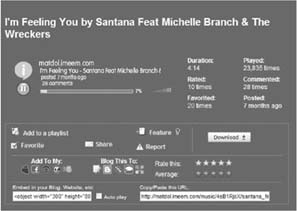
FIGURE 12.12 Imeem song page with many communication features. (Permission granted from imeem.)
With imeem, you have the opportunity to develop the artist's profile, including photos, font styles, theme, and layout. All aspects of the page can be edited or adjusted, including the page header, section headers, wallpaper background, and general page settings.
The profile layout has areas for posting upcoming events, bio (about) music, playlists, friends and groups, and recent media.
The song load section allows for uploading an album cover, song title, artist, album, description, and tags. Imeem supports either MP3, OGG, WMA, or M4A formats. The only place to add HTML code to imeem profiles is in the “profile comments” box. Once the HTML is posted, the correlating images and links appear. If the HTML code is not interpreted correctly for some items, such as pulling images from other sites, it may be necessary to adjust and preview until everything is in order.
Imeem also allows for analyzing user traffic with the “view stats” feature. You can see how many hits each item gets.
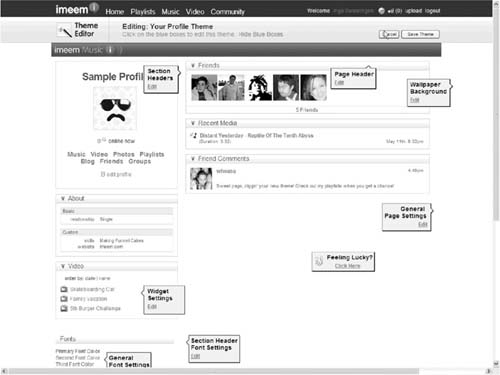
FIGURE 12.14 Page layout for imeem (permission granted from imeem).
BEBO
Another social networking site, Bebo, is not as heavy on music but does offer some music features. Bebo describes itself as a social media network. Bebo is similar to imeem in that an artist's personal profile and band profile are separate (Harbin, 2007). Band profiles provide different features that help promote the artist, such as tour dates and list of fans. Users can add their AIM, Skype, and Windows Live Messenger user names to their profiles. Members also have the opportunity to create fan groups, to support their favorite artists, and create playlists for other members to listen to.
First, you must sign up for a user account. Under profile information, you can add the band's bio or other personal information. After the account is created, that becomes the personal home page. After the profile is completed on the artist's “home” page, click on “Music” to build a musician or band profile. Under the music tab, you can select “register your band,” which loads a submission page called register your music, which allows you to upload your music.
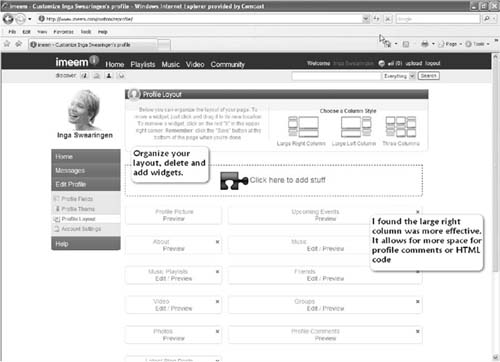
FIGURE 12.15 Imeem layout for an artist account (permission granted from imeem).
When the “register band” fields have been completed, click on the image under the caption “Band member of” to start creating the band profile, including selecting photos, skins, and a background layout. The photo tab allows you to upload photos, music, and videos.
Bebo has profile modules that you can use and arrange to provide features for the page. The modules include band members, fans, video box, polls, blog, upcoming shows, music store, songs, music albums, photos, comments, white board, wall, widgets, and my skins. For the “upcoming shows” feature, you are prompted to enter dates, times, duration, location, and details on each show. Bebo provides “web badges,” which are graphical widgets that can be pasted on other sites and blogs directing web surfers to the artist's Bebo page.
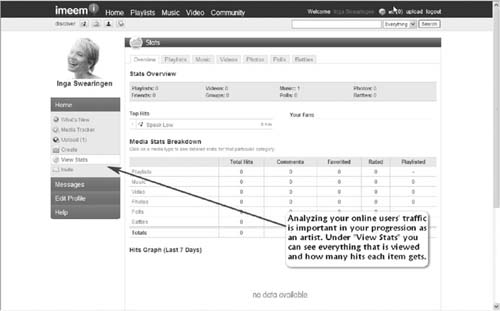
FIGURE 12.16 Imeem statistics (permission granted from imeem).
OTHER SOCIAL NETWORKING SERVICES
There are plenty of other social networking services and several upstarts that focus on music. Some of these sites may take off in popularity, whereas others may falter.
- BlackPlanet. This is a social networking site focused on African Americans, offering networking and news about what's hot in music, fashion, sports, and events in the black community. The network offers music features including streaming, creating playlists and having members add their favorite artist to their profile. BlackPlanet is also connected through imeem, so that songs previewed there can be added to the user's BlackPlanet profile.
- Hi5. This is another social networking service with a large music component. Their web site calls it “the place where young people come to stay in touch with friends, meet new people, create & explore content, and express themselves. hi5 provides a platform for established artists, underground talent, and everyday people to all gain prominence amongst a worldwide audience. Our members voice their opinions and increase the significance of an artist, a person, or a piece of content.”
- MOG. MOG connects users by recommendations and by matching those with similar tastes in music. It has direct links to Amazon and iTunes for music purchases. It has a widget that tracks the user's listening habits on iTunes. MOG has features to create artist profiles.
- Music.com. This online community (still in the beta stage at the time of this writing) provides for user rating and creation of favorites lists. It also features artist profiles.
- ReverbNation. Provides a platform for artists to feature their music, profiles, tour schedules and so forth, and share this information with fans and industry people. The service features widgets to add the artist's profile to popular social networks.
FIGURE 12.17 Imeem upcoming shows feature (permission granted from imeem).
With so many new social networking services cropping up, no one is certain what will be the “next big thing.” An astute marketing manager learns to stay abreast of the changing trends in social networking and respond quickly and comprehensively to changes in the marketplace for social interaction.
LISTS OF SOCIAL NETWORKING SITES
The Social Network list: http://mashable.com/2007/10/23/social-networking-god
The Wikipedia list: http://en.wikipedia.org/wiki/List_of_social_networking_websites
Author's updated list: www.WM4MB.com
The ultimate Web 2.0 reference site: www.go2web20.net
GLOSSARY
Blogging or blog — Short for weblog, it is a personal online journal that is frequently updated and intended for general public consumption.
Hypertext markup language (HTML) — The predominant authoring language for the creation of web pages. HTML defines the structure and layout of a web document by using a variety of tags and attributes.
Social networking — The practice of interacting with and expanding the number of one's business or social contacts by making connections typically through social networking web sites such as MySpace and Facebook.
URL — Uniform Resource Locator, the global address of documents and other resources on the Web. The first part of the address is called a protocol identifier, and it indicates what protocol to use; the second part is called a resource name, and it specifies the IP address or the domain name where the resource is located.
Viral marketing — A marketing phenomenon that uses online social networking to facilitate and encourage people to pass along a marketing message voluntarily and exponentially. Sometimes the marketing message is imbedded in, or attached to, a message that participants find interesting and are willing to forward to others.
Web widgets — A widget is a small application that can be ported to and run on different web pages by a simple modification of the web page's HTML.
WYSIWYG — Pronounced WIZ-zee-wig, short for “what you see is what you get.” A WYSIWYG application enables you to see on the display screen exactly what will appear when the document is printed or published to the Web.
REFERENCES AND FURTHER READING
Baker, Bob. (2006, July 1). MySpace music marketing: How to promote & sell your music on the world's biggest networking web site. http://www.bob-baker.com/buzz/bobbooks.html.
Boyd, Danah, and Ellison, Nicole. (2007). Social Networking sites: Definition and conception, www.danah.org/papers/worksinprogress/SNSHistory.html.
Brothers, Patrick, and Layton, Julia. (2007). How MySpace works, http://computer.howstuffworks.com/myspace.htm.
Cio-today. (2008, January 30). Could social networking save the music industry, www.cio-today.com/story.xhtml?story_id=011001CRJKFU.
Dawes, John, and Sweeney, Tim. (2000). The Complete Guide to Internet Promotion for Artists, Musicians and Songwriters. Tim Sweeney and Associates, Temecula, CA.
Greenberg, Dan Ackerman. The secret strategies behind many “viral” videos: A case study. www.techcrunch.com/2007/11/22/the-secret-strategies-behindmany-viral-videos.
Harbin, Jennifer. (2007). Universal Music Group new media intern guide. Unpublished manuscript.
Hitwise. (2007, March 14). IMeem and Bebo are the fastest movers, www.hitwise.com/press-center/hitwiseHS2004/socialnetworkingmarch07.php.
MacPhearson, Michelle. (2007, February 5). Viewing and posting bew Myspace. Bulletins, www.articles3000.com/Internet/60055/Viewing-And-Posting-New-Myspace-Bulletins.html.
Mills, Elinor, Advertisers look to grassroots marketing, http://news.com. com/2100-1024_3-6057300.html.
Nevue, David. (2005). How to Promote Your Music Successfully on the Internet. Midnight Rain Productions. Eugene, OR.
Veiga, Alex. (2008, April 4). MySpace will offer musicians a new outlet. The Tennessean, section E, p. 1.
Vincent, Frances. (2007). MySpace for Musicians. Thomson Course Technology, Boston, MA.
1 Michael Richards, who played Kramer on Seinfeld, was caught on video in a racially-tinged rant at a comedy club. One of the club's patrons used a cell phone to capture the moment and it was publicly disseminated, much to the dismay of Richards.
